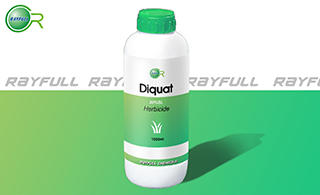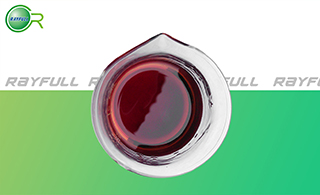DIQUAT
  敌草快 敌草快
Introduction: Diquat is a non-residual bupyridyl herbicide and crop desiccant used mainly to control broad-leaved weeds and grasses in Potatoes; oilseed rape; fruit including apples, pears, peaches, plums, citrus, olive, grapes; tomatoes; sunflowers; vegetables including beans & peas, carrots, onions, chicory; sugarbeet.
Common name: Diquat
Another name: DIQUAT DIBROMIDE, Aquacide, Deiquat, Detrone, Preeglone, Reglone, Reglon, Ortho-Diquat, Reglox, etc.
Chemical name: 9,10-dihydro-8a,10a-diazoniaphenanthrene dibromide
Empirical formula: C12H12N2Br2
Structural formula:

Mol. Weight: 344.05 g/mol
CAS No.: 85-00-7
Specifications
Leading Diquat supplier
Diquat 200 g/L SL
Diquat 40% TC
Diquat 95% TC
Packing:
BULK PACKING
Solid: 25kg/Bag, 25kg/Drum, 50kg/Drum etc.
Liquid: 200L/Drum, 20L/Drum, 10L/Drum ect.
SMALL PACKING
Solid: 1kg/Alu bag, 500g/Alu bag, 200g/Alu bag, 100g/Alu bag, 50g/Alu bag, 15g/Alu bag etc.
Liquid: 5L/Drum, 1L/Bottle, 500ml/Bottle, 250ml/Bottle, 100ml/Bottle, 50ml/Bottle etc.
Customerized packing label
Diquat FAO standard
Professional registration
HAZARDS IDENTIFICATION
Hazard statement(s)
H302: Harmful if swallowed.
H315: Causes skin irritation.
H317: May cause an allergic skin reaction.
H319: Causes serious eye irritation.
H330: Fatal if inhaled.
H335: May cause respiratory irritation.
H372: Causes damage to organs through prolonged or repeated exposure.
H410: Very toxic to aquatic life with long lasting effects.
Precautionary statement(s)
P260: Do not breathe dust/fume/gas/mist/vapors/spray.
P261: Avoid breathing dust/fume/gas/mist/vapors/spray.
P264: Wash ... thoroughly after handling.
P270: Do not eat, drink or smoke when using this product.
P271: Use only outdoors or in a well-ventilated area.
P272: Contaminated work clothing should not be allowed out of the workplace.
P273: Avoid release to the environment.
P280: Wear protective gloves/protective clothing/eye protection/face protection.
P284: [In case of inadequate ventilation] Wear respiratory protection.
P301+P312: IF SWALLOWED: call a POISON CENTER/doctor/... IF you feel unwell.
P302+P352: IF ON SKIN: wash with plenty of water.
P304+P340: IF INHALED: Remove person to fresh air and keep comfortable for breathing.
P305+P351+P338: IF IN EYES: Rinse cautiously with water for several minutes. Remove contact lenses if present and easy to do - continue rinsing.
P310: Immediately call a POISON CENTER or doctor/physician.
P312: Call a POISON CENTER or doctor/... if you feel unwell.
P314: Get medical advice/attention if you feel unwell.
P320: Specific treatment is urgent (see ... on this label).
P321: Specific treatment (see ... on this label).
P330: Rinse mouth.
P332+P313: IF SKIN irritation occurs: Get medical advice/attention.
P333+P313: IF SKIN irritation or rash occurs: Get medical advice/attention.
P337+P313: IF eye irritation persists: Get medical advice/attention.
P362: Take off contaminated clothing.
P363: Wash contaminated clothing before reuse.
P391: Collect spillage.
P403+P233: Store in a well-ventilated place. Keep container tightly closed.
P405: Store locked up.
P501: Dispose of contents/container to ...
Supplemental Hazard Statements: none
MAMMALIAN TOXICOLOGY
Acute toxicity: 1) Acute oral LD50 for rat: 1000 a.i.mg/kg. 2) Acute dermal LD50 for rat: 2000 a.i.mg/kg. 3) Inhalation LC50 (4 h) for rat: >0.5 a.i.mg/L. 4) Slightly-irritating to skin (rabbits). 5) Mildly-irritating to eyes (rabbits). 6) Not a contact sensitizer (guinea pigs).
NOEL: (2 y) for rats is 0.47 mg/kg b.w. daily; (4 y) for dogs is 94 mg/kg diet.
ADI (JMPR): 0.006 mg/kg b.w. [2013]
Classification:
Toxicity class WHO (a.i.): II (Moderately hazardous)
US EPA Classification (formulation): II (Warning - Moderately toxic)
EC Risk Classification: T+ - Very toxic: R26; T - Toxic: R48/25; Xn - Harmful: R22, R43; Xi - Irritant: R36/37/38; N - Dangerous for the environment: R50, R53
ECOTOXICOLOGY
Effect on birds: high toxicity to birds, acute LD50 for Mallard ducks is 71 a.i.mg/kg. Effect on fish: moderate toxicity to fish, acute 96 hour LC50 for Rainbow trout is 67.0 a.i.mg/L. Effect on aquatic invertebrates: moderate toxicity to aquatic invertebrates, acute 48 hour EC50 for Daphnia magna is 1.2 a.i.mg/L. Effect on algae: moderate toxicity to algae, acute 72 hour EC50 for Pseudokirchneriella subcapitata is >0.011 a.i.mg/L. Effect on honeybees: moderate toxicity to honeybees, contact acute 48 hour LD50 is >20.1 a.i.μg/bee, oral acute 48 hour LD50 is 50.7 a.i.μg/bee. Effect on earthworms: moderate toxicity to earthworms, acute 14 day LC50 is 94.3 a.i.mg/kg.
ENVIRONMENTAL FATE
Diquat dibromide's production may result in its release to the environment through various waste streams; it's use as a non-selective contact herbicide, algicide, desiccant, and defoliant may result in its direct release to the environment. If released to air, a vapor pressure of <<1.0×10-7 mm Hg at 25 deg C indicates diquat dibromide will exist in the particulate phase in the ambient atmosphere. Particulate-phase diquat dibromide will be removed from the atmosphere by wet and dry deposition. Diquat has an absorption maximum at 310 nm and is therefore susceptible to UV decomposition. However, when adsorbed on particulate matter, no photodegradation occurs. If released to soil, diquat dibromide is expected to have slight mobility based upon an estimated Koc of 2,000. Volatilization from moist soil surfaces is not expected to be an important fate process based upon an estimated Henry's Law constant of 1.4×10-13 atm-cu m/mole. Diquat dibromide is a divalent cation and cations generally adsorb to organic carbon and clay more strongly than their neutral counterparts. Biodegradation is not expected to be an important environmental fate process as diquat dibromide reached 0% of its theoretical BOD using the Japanese MITI test. If released into water, diquat dibromide is expected to adsorb to suspended solids and sediment based upon the estimated Koc. Diquat dibromide will exist almost entirely in the ionized form at pH values of 5 to 9 and therefore volatilization from water surfaces is not expected to be an important fate process. A BCF range of 0.6 to 1.4 suggests bioconcentration in aquatic organisms is low. Diquat dibromide is stable in neutral or acid solutions; however, it hydrolyzes in alkaline waters.
Usage: Herbicide reported by R. C. Brian et al. (Nature (London), 1958, 181, 446). Introduced by ICI Plant Protection Division (now Syngenta AG) and first marketed in 1962. Patents: GB 785732. Manufacturers: Syngenta. Biochemistry: During photosynthesis, superoxide is generated, which damages cell membranes and cytoplasm.
Application: Non-selective contact herbicide and desiccant, absorbed by the foliage, with some translocation in the xylem. Pre-harvest desiccation of cotton, flax, alfalfa, clover, lupins, oilseed rape, poppies, soya beans, peas, beans, sunflowers, cereals, maize, rice, sugar beet, and other seed crops; destruction of potato haulms; and stripping of hops. Control of annual broad-leaved weeds in vines, pome fruit, stone fruit, bush fruit, strawberries (also control of runners), citrus fruit, olives, hops, vegetables, ornamental plants and shrubs, and other crops. Control of emergent and submerged aquatic weeds. Weed control on non-crop land. Weed control and tassel inhibition in sugar cane. Application rates 400-1000 g/ha.
| 






